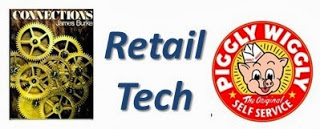-- How Piggly Wiggly Built Today's Self-Checkout Legacy --
"An invention acts rather like a trigger, because, once it's there, it changes the way things are, and that change stimulates the  production of another invention, which in turn causes change, and so on. Why those inventions happened between 6,000 years ago and now, where they happened, and when they happened , is a fascinating blend of accident, genius, craftsmanship, geography, religion, money, ambition..." (1) -- James Burke
production of another invention, which in turn causes change, and so on. Why those inventions happened between 6,000 years ago and now, where they happened, and when they happened , is a fascinating blend of accident, genius, craftsmanship, geography, religion, money, ambition..." (1) -- James Burke
Thirty five years ago, British science historian James Burke created, wrote, and presented the BBC documentary television series "Connections: An Alternative View of Change". Unlike linear historical narratives, Burke's approach demonstrated how inventions, scientific discoveries, and world events are built and interconnected to one another, ultimately building to today's modern technology.
The "Connections" television series was one of my early inspirations on becoming a lifelong student of technological change and how it is constantly re-shaping the human experience. Just a few insights from the series (2):
- A 16th Century doctor at the court of Queen Elisabeth did something that made television possible in the modern world.
- 18th Century merchants who were worried about ship bottoms eventually led to the invention of plastic.
- A group of French monks and their involvement with sheep rearing helped give the modern world the computer.
- The chronology from European medieval people tending their fires to today's motor car manufacturing.
One of my early career mentors inspired this week's post when he shared the history of the Piggly Wiggly supermarket chain.(3) In 1916, Clarence Saunders opened the first self service Piggly Wiggly grocery store where consumers no longer handed a shopping list to a store employee behind the counter.
A selected number of technological contributions from Piggly Wiggly included the FIRST to:
- Provide checkout stands.
- Price mark every item in the store.
- Give shoppers more for their food dollar through high volume / low profit margin retailing.
- Feature a full line of nationally advertised brands.
The connections to above retail evolutionary steps to today's modern retail store are startling.
- Today's checkout stands have evolved to include computer cash registers, self checkout POS, loyalty programs, MSRs to accept debit / credit, time & attendance integration, impulse buying displays, under the cart video technology, data analytics to track cashier productivity, video to detect employee theft, video analytics to detect collusion & count how many people are in line, and marketing differentiation touting why "our" lines are shorter.
- Price marking every item led to the invention of bar code scanning, paper shelf labels, followed by electronic versions, and lately item level RFID.
- The entire discounting sector of retail has its origin in high volume / low profit margin retailing first introduced by Piggly Wiggly.
- Focus on national brands led to manufacturer retail channel control. Bar code scanning transferred channel control back to the retailer.
Temptation would be to limit your search for the next retail technology solution from the early work started by Saunders and subsequent product extensions.
As Burke asserted in the "Connections" TV series, in school, we are all taught in linear segregated list of subjects. Take his example of agriculture:
"The minute you look at this apparently clear-cut view of things, you see the holes. I mean look at the tractor. Oh sure, it worked in the fields, but is it a part of the history of agriculture or a dozen other things? The steam engine, the electric spark, petroleum technology, rubber technology. It's a countrified car. And, the fertilizer that follows; it doesn't follow! That came from as much as anything else from a fellow trying to make artificial diamonds." (1)
The next technological waves re-shaping retail are not coming from the Saunders baseline inventions. The Internet and mobile devices are shifting retail channel control to the consumer.
Want to thrive as a technology company developing solutions for the retail industry?
- Stop thinking about technology in linear product extension terms.
- Observe the consumer adoption patterns of personal technologies.
- Understand that the future of retail starts and ends with customer experiences in an increasingly onmichannel shopping world.
Retail connections are evolving, requiring more than ever an alternative view of technology change.
(1) http://ow.ly/pOkQo (2) http://ow.ly/pOl7n (3) http://ow.ly/pOlnd Images from http://ow.ly/pOlAM / http://ow.ly/pOlnd
















